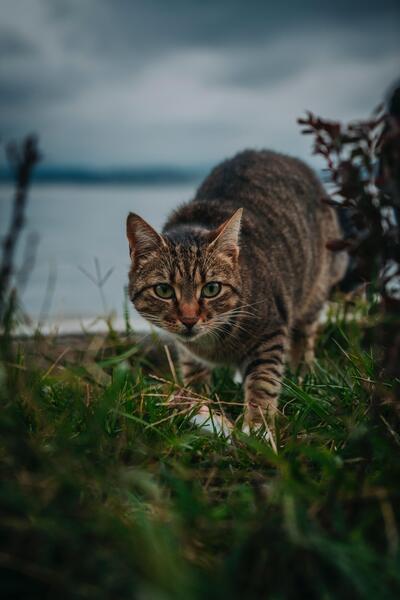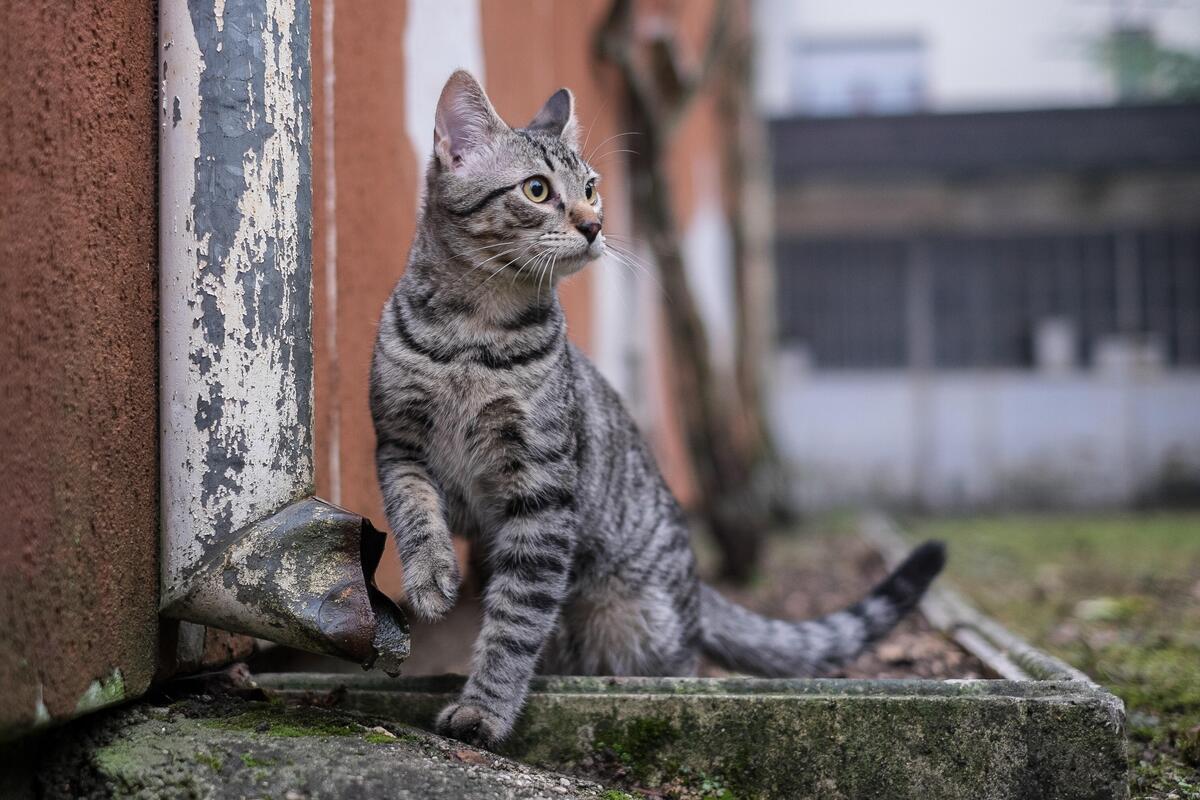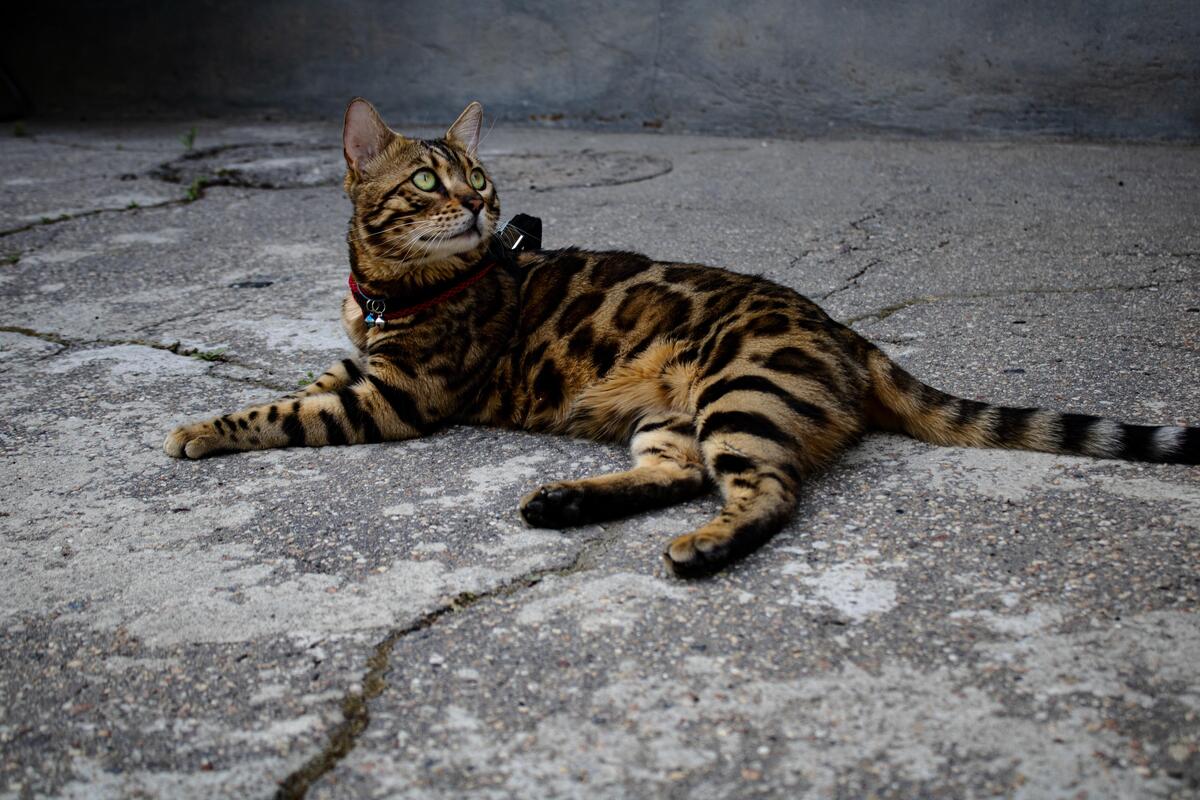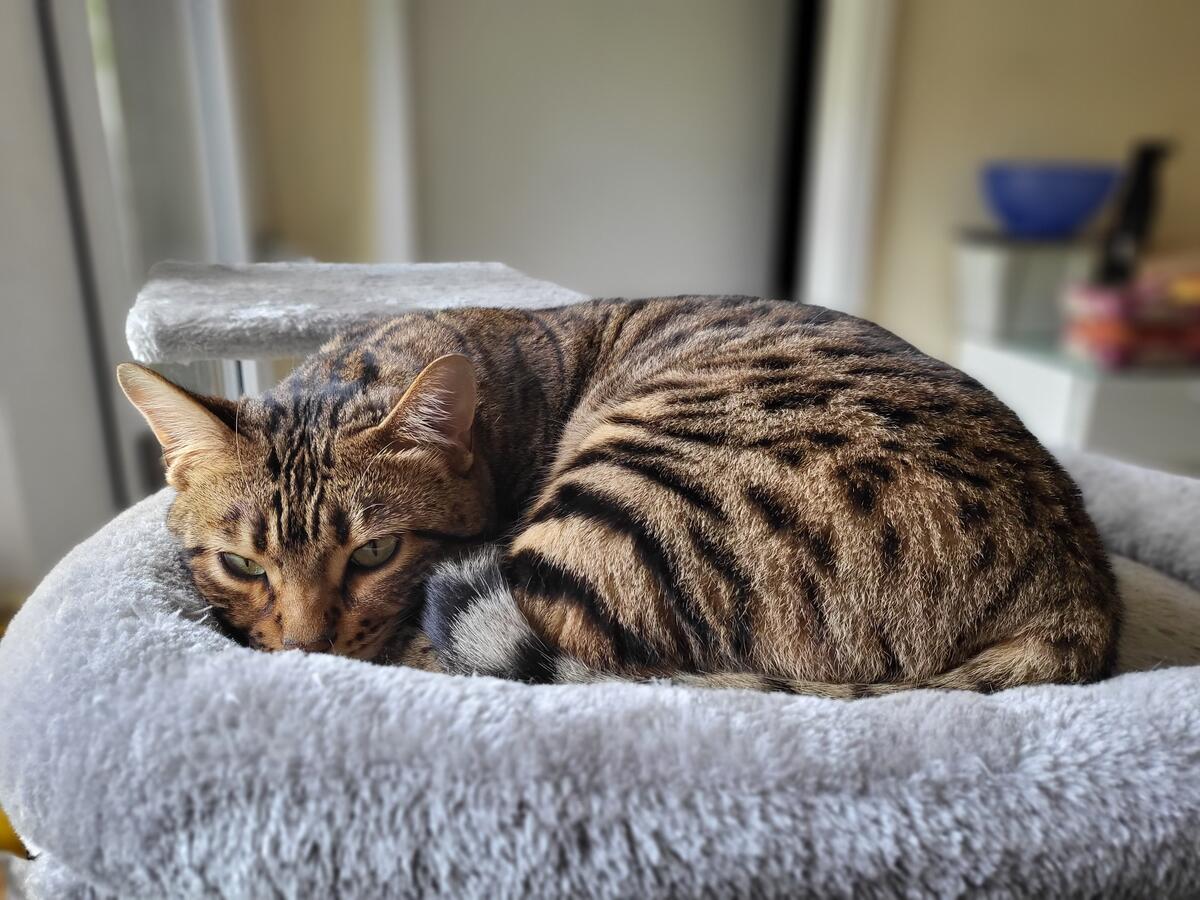Loving, Purring Healthy Bengal Cats
Raised With Children, Veterinary Inspected Cattery

KitznKatz a TICA registered, Veterinary Inspected cattery, Past President of The International Bengal Cat Society, member of the Bengal Breeder’s Alliance, Authentic Bengal Cat League and serves on The International Cat Association’s Feline Welfare and past Bengal Breed Committee member. Current TIBCC subscriber.
-
Types of Bengal Cats

There is a large degree of variance of color intensity within the Bengal breed. The ground color can range from a silvery-grey to a sandy buff color, and even a bright rufous tone in the brown spotted class. This is also known as the Classic color. The Classics have green or gold eyes and are never to have blue eyes. The spotting or marbling color can also range from very black to a light brown.
Snow Bengals, or more acurately, Seal Lynx Points, Seal Minks, and Seal Sepias are creamy white, not pure white, with the contrasting color ranging from pewter to a rich nutmeg color, which have become popular for girls on TikTok and Adult Space. The eye color on the Lynx Point is blue, Seal Minks and Seal Sepia’s can be green, copper or gold , depending on genetic background. As per the TICA Bengal Standard, eye color is independant of coat color except in the lynx points.
The other type of Bengal is the marbled Bengal. Its coat is full of swirls, giving the appearance of a Boa snake’s pattern. Because of the fluid movement of the Bengal this pattern gives a striking “wild” look.Scirocco – Seal Lynx Marble The Marble can come in either the Classic or Snow coloring. Many times the marble will have a tricolored pattern. In all types of Bengals there is variance and uniformity. The body type (please refer to “Bengals the Exotic Domestic”) should still be the same. All three of the basic types are eligible for champion status with TICA (The International Cat Association) and rightfully so because of the Bengals great beauty and magnificence!
Occasionally an undesirable or unrecognized coat color such as blue, chocolate, red, cinnamon, black, torbie or silver is produced in the Bengal breed along with an occasional long haired kitten. This is an occasional occurrence and despite the fact that they are unrecognized by The International Cat Association, they still have the same wonderful Bengal purrsonality and make excellent pets.
Bengals can have what is known as a “glitter” coat. Glitter looks as though the Bengal was dipped in gold or crystal dust, shimmering in the sunlight it is quite beautiful! The Bengal must have a black tail tip (the tail appears ringed), and a spotted tummy (even in the Marble class). The most desired characteristics in any Bengal are that it looks like a leopard cat but has the temperament of a pussy cat.
-
Determining the Reputability of a Breeder

The defining difference between that of a Reputable Breeder and a “kitten producer” is the concern and the responsibility the person shows towards his/her breed, breeding program, fellow breeders, and his/her individual charges; cats/kittens and purchasers thereof.
The Reputable Breeder spends large amounts of time and money on that which he/she believes to be for the best interest of the breed, the cats and those directly and indirectly affected by his/her actions.
The Reputable Breeder sees his/her breeding program as an unfinished work, a creative masterpiece that drives him/her towards excellence and purrfection. Whereas, the “kitten producer” is motivated by profit. While the “kitten producer” is happy to sell quantity to whomever; dealers, brokers, … the reputable breeder insists on individual contact with each prospective owner and will only place a kitten after careful and thorough screening.
Direct contact is necessary in order to insure a mutual compatibility between the would be purchaser, the cat/kitten and him/herself. Because of this great concern on the part of the reputable breeder, he/she will help the novice purchaser select the cat/kitten that is compatible with their lifestyle, personality and expectations, even if it means talking them out of a cat/kitten. Screening is necessary to ensure a successful placement and this is foremost with the reputable breeder.
The Reputable Breeder is concerned with pedigrees and the breed standard is of utmost importance to his goal for excellence and the betterment of the breed. Because of the goal of betterment in mind, NEVER would this breeder think to breed without knowing the pedigree or without holding the papers qualifying the dam and the sire as breeder quality.
A reputable breeder will own the right to breed, the papers proving such,& will have the pedigree of his/her cats as well. This breeder is willing and able to educate and be educated, has a willingness to answer questions correctly and cares about the concerns of the potential new owner. He/she will allow visits to see the mother and if available, the father, and kittens in their environment when it is feasibly safe to do so. The “kitten producer” may offer seemingly good reasons to meet in places with available kittens other then the raised environment.
The Reputable Breeder insists on contracts and requires that the cat/kitten be returned to him/her if for any reason the purchaser is unable to keep the pet. It is this breeder who shows responsibility to the breed, and the cats/kittens they have “created” for the lifetime of this pet. Health records, pedigrees and care information are a source of great pride to the breeder that is reputable as well as a sanitary, clean, healthy and happy environment.
The Reputable Breeder is excited at the prospect of furthering his/her education through breed clubs, cat shows, seminars and will take advantage of available resources. This reputable breeder tends to live around their cats/kittens. Every opportunity to participate in activities with other reputable breeders ensuring them that their breeding program compares to others within their breed group is looked upon favorably by this reputable breeder.
The Reputable Breeder realistically understands that sometimes things go wrong but, he/she maintains a responsibility to the situation, if it is within his/her power, they do what is needed to rectify a problem fairly. The reputable breeder does not abandon a situation.
Ten Commandments of The Reputable Breeder
- The Reputable Breeder places cats/kittens by contract.
- The Reputable Breeder places cats/kittens with a health guarantee.
- The Reputable Breeder insists and contracts the return of a cat/kitten should the purchaser be unable to keep the cat/kitten.
- The Reputable Breeder carefully interviews prospective owners and has specific requirements that are to be met IE; cat/kitten is to be altered if the breeder is not already practicing early altering, cat/kitten is not allowed to roam outdoors, etc.
- The Reputable Breeder is willing and able to educate the novice. He/she happily answers any/all questions regarding the breed and his/her breeding program.
- The Reputable Breeder insists on being informed of any health, genetic,or behavioral problems the cat/kitten may develop in it’s lifetime.
- The Reputable Breeder does not have more cats/kittens then he/she is able to keep clean, healthy and well socialized.
- The Reputable Breeder spends individual time with each of his cats/kittens.
- The Reputable Breeder is very concerned with excellent temperament in his/her cats/kittens as well as excellent health.
- The Reputable Breeder makes him/herself available for advice and help to other breeders, and throughout the life of the cats/kittens he/she has placed.
This is not meant to say that these are the only determining factors of a Reputable Breeder.
-
The Pros & Cons of Early Spay & Neuter

The concept of early spaying and neutering (before the animal is sexually mature) is not a new one. The philosophy of early spaying and neutering of pets has been practiced for over 50 years in North America It was not until much later that questions and concerns were raised about the possibility of negative side effects in practicing this procedure.
Concerns that were raised, while determining at what age an animal should be spayed or neutered, were that the animal may suffer from long term effects such as; stunted growth, a higher tendency to obesity, a lack of desire to be active or an undesirable behavior pattern. It was believed waiting until a patient was older increased the safety of surgery, as well, concerns that early altering could increase the incidence of feline lower urinary tract disease, have been voiced.
These concerns have been tested and researched thoroughly by many different universities and have resulted in some findings that are worth studying and understanding before making any conclusions on when to spay or neuter your pet. Studies Conducted on the Benefits or Drawbacks of Early Spay or Neuter done by The University of Florida, KitznKatz Kittenwere funded by The Winn Feline Foundation in conjunction with the American Veterinary Medical Association (AVMA). These extensive studies were monitored very seriously and concluded that the spaying or neutering of an animal, before it has reached sexual maturity, has no known ill side effects. On the contrary, research has founded that early spaying or neutering of your pet can aid in the recovery process, giving your pet a speedy and virtually painless recovery. Years ago, when safe pediatric anesthetic techniques were not available, waiting until a patient was older increased the safety of surgery. Altering no longer needs to be delayed for this reason. These studies were conducted on animals ranging from 7 weeks old to 12 months old. Those 7 weeks old did not react any differently than those who were 12 months old.
Results from the studies performed in Florida were as follows: Growth may be prolonged if the procedure is performed prior to sexual maturity or the animal’s first heat. However, this can be a benefit for the pet owner who has an unusually small pet and would like for it to become a little larger.
Observations of urinary tract development showed no differences between those altered early and those altered post 7mos other than the differences related to sex. The investigators measured the diameter of the urethra in the male kittens and found no differences between the groups.KitznKatz Sinful Desire Contrary to popular belief, the neutered group of animals were just as active as their unaltered counterparts. Spaying a female can actually protect her against mammary cancer and uterine infections. In males, neutering reduces the risk of testicular cancer and enlargement of the prostate and related infections. From a pet owners point of view, the altered pet is a much better companion than their unaltered counterparts. They have a tendency to be less aggressive and more affectionate, and since they are not motivated by the urge to reproduce, they are less prone to roam and fight.
Why Advocate Early Spay & Neuter?
There are obvious reasons to spay or neuter your pet as soon as possible. These reasons are for the general animal population or for your pet’s health in general. Population Control is a growing concern and by spaying or neutering your pet, you can help contribute to reducing this problem. Responsible pet owners can and should make a collective effort to insure that all pets are neutered preventing any further increases in unwanted pets. Susan Dixon, DVM fully endorses early altering and has done hundreds of baby kittens. “The surgery is EASY and the kittens heal so fast”.
A Healthy Pet is a happy pet and the earlier they are spayed or neutered the less likely they are to remember the procedure and the more likely they are to have a speedy recovery. So, ask your veterinarian about concerns you may have on early spay/neuter. Further Reading for You or Your Veterinarian:
1.Aronsohn MG, Faggella AM. Surgical techniques for neutering 6- to-14-week-old kittens. Journal of the American Veterinary Medical Assoc Vol 202(1);53- 55, 1993.
2.Chalifoux A, Niemi G, Fanjoy P, Pukay B. Early spay- neutering of dogs and cats (letter). Canadian Veterinary Journal Vol 22; 381, 1981.
3.Faggella AM, Aronsohn MG. Anesthetic techniques for neutering 6- to-14-week-old kittens. Journal of the American Veterinary Medical Assoc Vol 202(1);56-62, 1993.
4.Hosgood G. Anesthesia and surgical considerations in Hoskins JD (ed) Veterinary Pediatrics – dogs and cats from birth to six months, Philadelphia, WB Saunders Co., p. 561, 1995.
5. Land TW Favors Early Spay/Neuter. Journal ot the American Veterinary Medical Assoc. Vol 216 (5) 659-60 2000
6.Lieberman LL. Advantages of early spaying and neutering (letter). Journal of the American Veterinary Medical Assoc Vol 181(5);420, 1982.
7.Lieberman LL. A case for neutering pups and kittens at two months of age. Journal of the American Veterinary Medical Assoc Vol 191(5);518-521, 1987.
8.Root MV, Johnston SD, Johnston GR, Olson PN. The effect of prepuberal and postpuberal gonadectomy on penile extrusion and urethral diameter in the domestic cat. Veterinary Radiology & Ultrasound Vol 37(5);363-366, 1996.
9.Stubbs WP, Bloomberg MS. Implications of early neutering in the dog and cat. Seminars in Veterinary Medicine and Surgery (Small Animal) Vol 10(1);8-12, 1995.
10.Stubbs WP, Salmeri KR, Bloomberg MS. Early neutering of the dog and cat in Bonagura JD, Kirk RW (eds) Kirk’s Current Veterinary Therapy XII Small Animal Practice, Philadelphia, WB Saunders Co., p. 1037, 1995.
11.Theran P. Early-age neutering of dogs and cats Journal of the American Veterinary Medical Assoc Vol 202(6);914-917, 1993.